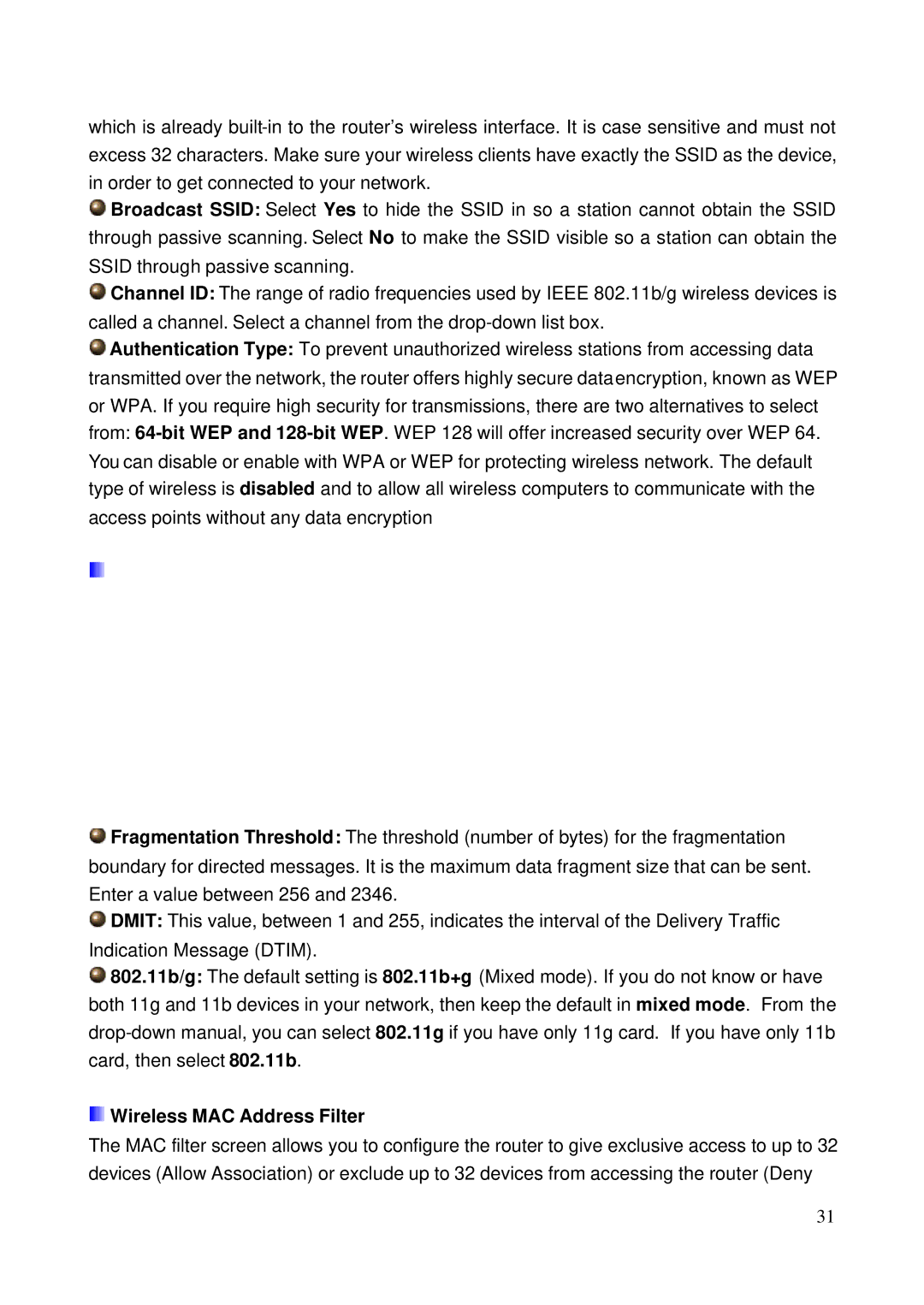which is already
![]() Broadcast SSID: Select Yes to hide the SSID in so a station cannot obtain the SSID through passive scanning. Select No to make the SSID visible so a station can obtain the SSID through passive scanning.
Broadcast SSID: Select Yes to hide the SSID in so a station cannot obtain the SSID through passive scanning. Select No to make the SSID visible so a station can obtain the SSID through passive scanning.
![]() Channel ID: The range of radio frequencies used by IEEE 802.11b/g wireless devices is called a channel. Select a channel from the
Channel ID: The range of radio frequencies used by IEEE 802.11b/g wireless devices is called a channel. Select a channel from the
![]() Authentication Type: To prevent unauthorized wireless stations from accessing data transmitted over the network, the router offers highly secure dataencryption, known as WEP or WPA. If you require high security for transmissions, there are two alternatives to select from:
Authentication Type: To prevent unauthorized wireless stations from accessing data transmitted over the network, the router offers highly secure dataencryption, known as WEP or WPA. If you require high security for transmissions, there are two alternatives to select from:
 Advanced Setting
Advanced Setting
![]() Beacon interval: The Beacon Interval value indicates the frequency interval of the beacon. Enter a value between 20 and 1000. A beacon is a packet broadcast by the Router to synchronize the wireless network.
Beacon interval: The Beacon Interval value indicates the frequency interval of the beacon. Enter a value between 20 and 1000. A beacon is a packet broadcast by the Router to synchronize the wireless network.
![]() RTS/CTS Threshold: The RTS (Request To Send) threshold (number of bytes) for enabling RTS/CTS handshake. Data with its frame size larger than this value will perform the RTS/CTS handshake. Entering a value above the maximum MSDU (MAC service data unit) size will turn off the RTS/CTS handshake. Setting this attribute to zero turns on the RTS/CTS handshake Enter a value between 1500 and 2347..
RTS/CTS Threshold: The RTS (Request To Send) threshold (number of bytes) for enabling RTS/CTS handshake. Data with its frame size larger than this value will perform the RTS/CTS handshake. Entering a value above the maximum MSDU (MAC service data unit) size will turn off the RTS/CTS handshake. Setting this attribute to zero turns on the RTS/CTS handshake Enter a value between 1500 and 2347..
![]() Fragmentation Threshold: The threshold (number of bytes) for the fragmentation boundary for directed messages. It is the maximum data fragment size that can be sent. Enter a value between 256 and 2346.
Fragmentation Threshold: The threshold (number of bytes) for the fragmentation boundary for directed messages. It is the maximum data fragment size that can be sent. Enter a value between 256 and 2346.
![]() DMIT: This value, between 1 and 255, indicates the interval of the Delivery Traffic Indication Message (DTIM).
DMIT: This value, between 1 and 255, indicates the interval of the Delivery Traffic Indication Message (DTIM).
![]() 802.11b/g: The default setting is 802.11b+g (Mixed mode). If you do not know or have both 11g and 11b devices in your network, then keep the default in mixed mode. From the
802.11b/g: The default setting is 802.11b+g (Mixed mode). If you do not know or have both 11g and 11b devices in your network, then keep the default in mixed mode. From the
 Wireless MAC Address Filter
Wireless MAC Address Filter
The MAC filter screen allows you to configure the router to give exclusive access to up to 32 devices (Allow Association) or exclude up to 32 devices from accessing the router (Deny
31
